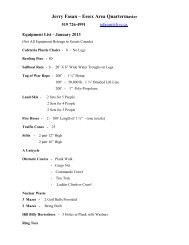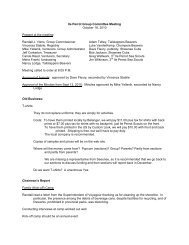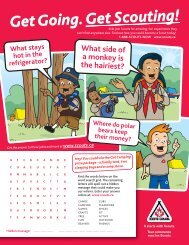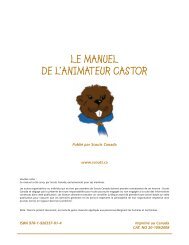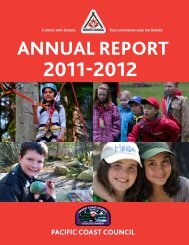Beaver Leader's Handbook - Scouts Canada
Beaver Leader's Handbook - Scouts Canada
Beaver Leader's Handbook - Scouts Canada
You also want an ePaper? Increase the reach of your titles
YUMPU automatically turns print PDFs into web optimized ePapers that Google loves.
Your <strong>Beaver</strong>s’ emotions are very intense, visible, and readily perceptible. Youngsters react to<br />
everything that goes on around them. Any disruption in their environment provokes an emotional<br />
response of one kind or another.<br />
<strong>Beaver</strong>s are sensitive to their relations with other people. They react at once to the quality of<br />
emotional, social or physical relationships. Both a warm welcome and indifference will affect<br />
them. Respect this fragile dimension of your <strong>Beaver</strong>s.<br />
CHARACTERISTICS OF BROWN, BLUE AND WHITE TAIL BEAVERS<br />
Although five to seven-year-olds share most of the age characteristics described in the profile,<br />
you’ll find subtle differences in the three tail groups. This makes sense when you consider that<br />
they have had varying degrees of exposure to school, colony meetings, family life, and other<br />
social situations. Here are some characteristics of the three groups of <strong>Beaver</strong>s.<br />
Brown Tails<br />
Everything is fresh and unique. These children are most likely entering kindergarten and beginning<br />
to experience the world outside their family and close friends. Initially, Brown Tails may be<br />
shy, unsure, and in awe of everything happening around them. Because <strong>Beaver</strong>s is new to them,<br />
it’s important to give them clear, straight-forward directions using simple words for activities.<br />
Brown Tails are learning to read and write; encourage their efforts and reassure them about<br />
their attempts.<br />
Blue Tails<br />
Through school, family activities and (perhaps) last year in <strong>Beaver</strong>s, Blue Tails have some previous<br />
experiences to build on. These <strong>Beaver</strong>s still like using physical contact to gather information,<br />
but are beginning to use their imagination in activities and projects.<br />
Blue Tails may show willingness to take on more responsibility; support their initiative and let<br />
them help.<br />
White Tails<br />
The last two years of school and <strong>Beaver</strong>s have given these youngsters self-confidence; they’re<br />
familiar with routines and activities. Their improved physical, mental and social abilities enable<br />
them to show their imagination and emerging personality.<br />
White Tails still need clear understandable instructions for activities, but now they can put<br />
more of their own personal touches on projects and will show initiative to do more things.<br />
Older White Tails may even be able to complete projects that stretch over several meetings.<br />
Such projects will stimulate their concentration, listening ability and budding sense of industry.<br />
They will also help prevent these <strong>Beaver</strong>s from becoming bored with the program.<br />
NEEDS OF BEAVER-AGED CHILDREN<br />
6-2<br />
If you’re aware of the developmental characteristics of <strong>Beaver</strong>-aged children, you can help<br />
<strong>Beaver</strong>s grow by:<br />
4 Being at ease with them, and letting them know you enjoy working with them.<br />
4 Letting them make mistakes that can’t harm them, and letting them know adults aren’t perfect.<br />
4 Expressing confidence in them through words, and giving them chances to try new things.



